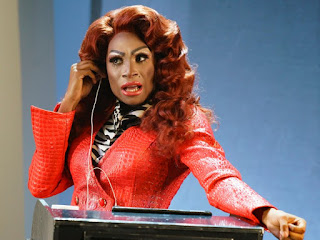Theater Review: Ain't No Mo, a black comedy that predicts a new migration
Ain’t No Mo
Written by Jordan E. Cooper
Directed by Stevie Walker-Webb
New York Public Theater
March 24, 2019
This raucous play by 24 year old black actor/writer Jordan E.
Cooper is a set of vignettes, mostly comic-satiric, reflecting on the current state
of black Americans, but with a horrific undertone. The 90-minute single act
consists of a variety of sketches, often similar to what one would see on an edgy
version of Saturday Night Live. The
play begins with a gospel funeral for a dead black man, “Mr. Right-to-Complain”,
now interred after Barack Obama is elected, setting an ironically optimistically
opening to the play. After this preamble, most of the remaining scenes flesh
out the play’s horrific central conceit that the US government, in a sort of
reparations, has decided to spend its money by flying each and every black American
to Africa, along with a bit of spending money. This is a fascinating echo of a
plan actually considered by Abraham Lincoln as a solution to slavery back in
the 1860s. We see a dinner party of elite entitled blacks reluctant to go, whose
earnest debate is interrupted by a crude-appearing, uncultured black woman who
breaks through the floor, having been locked in their (subconscious) basement. She
turns out to encompasses historical US black identities ranging from Louis
Armstrong to OJ Simpson to Toni Morrison to Stepin Fetchit, and the well-healed
group want her to return to the basement where she came from, so they can continue
to pursue the real goal of ambitious blacks, neither black nor white, but “financial
green”. Another scene shows a talk show of black women, focusing on one of
them, who is white, wanting acknowledgement for her “trans racial” choice, and
who insists on being called black. This comic scene stirred the argument of
what exactly is blackness, or race—biological or cultural? Even if it is
scientifically dubious, is it a reasonable label for anyone who is perceived to be part of a minority
group, and thus bear the brunt of prejudice, whether or not they wish to be included
in that group? Another scene occurs in a prison, as jailed blacks are liberated
for their flight to Africa, and in the airport—at gate 1619, the year slaves were
first imported to American colonies. Here the wonderfully bitchy flight
attendant explains that all departing blacks must look and walk straight ahead.
If they look back they will be turned into white people, and their place will
be taken by a Latino standby passenger—a nice take on the Orpheus legend. As the
final passenger leaves, it becomes unclear whether a final piece of luggage,
which contains all the accomplishments of black Americans, should leave with
them too. This piece of luggage was onstage pre-performance, and the audience
was encouraged to write an accomplishment of black Americans on a piece of
paper and drop it into the bag.
The set consisted of very simple, yet effective props, like
a very high quality college comedy review. The standout in the cast of eight was
the tall Hermon Whaley, in a cross-dressing role portraying the bitchy African-American
Airlines (AAA) attendant Peaches Standby.
This tall actor was dazzlingly
attired in matching pink suit and luggage, and showed great versatility as she
checked in the last flight to Africa from the US. These scenes were the
highlight of the play dramatically and comedically, largely due to Mr. Whaley’s
talent and passion. But the central conceit of all the black people leaving the
country never really reached the tragic and dramatic potential it offered. It’s
not easy to hit this balance of comedy and tragedy right. Jordan Peele’s movie Get Out (2017) did so while portraying another
science fiction metaphor of black rage, this time as white people literally
take over strong black bodies. While I
laughed and admired the creativity of this young playwright, the vignettes of Ain’t No Mo lacked enough continuity to
build any sort of tension, and the black exodus theme was presented as a given,
and deserved more non-comic reflection as a metaphor for the current state of
affairs. In the end I was not sure of what the author’s point of view really
was, since the play included so many themes now prevalent in black drama—white entitlement,
black abandonment or acceptance of American vs. African culture, poverty, imprisonment,
etc. I suspect he was most interested in reflecting on the dichotomy of black
contributions to culture vs. their current and past treatment by the white majority.
I wish his creative reflections had held together better to create a more
unified play.

Comments
Post a Comment